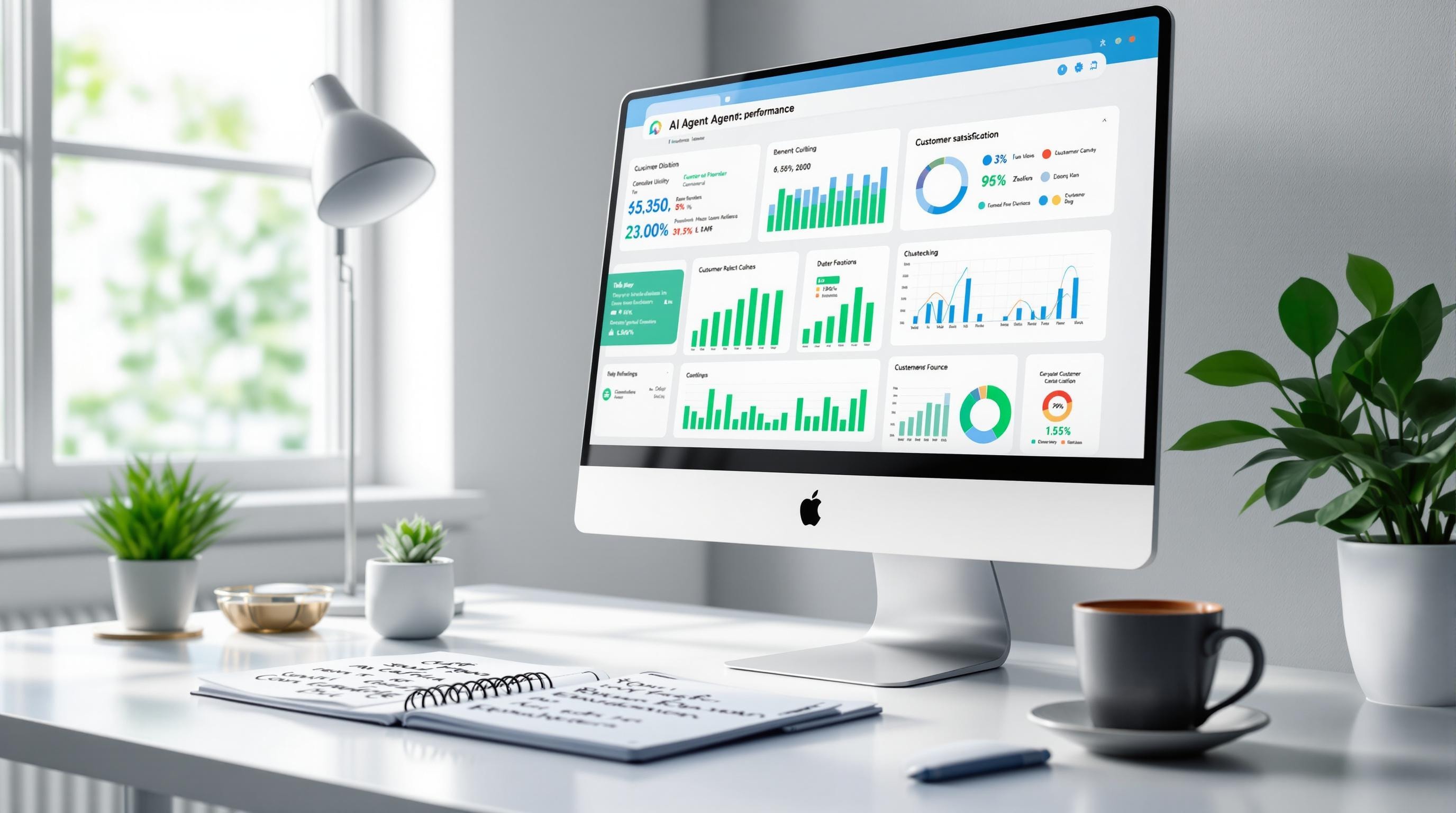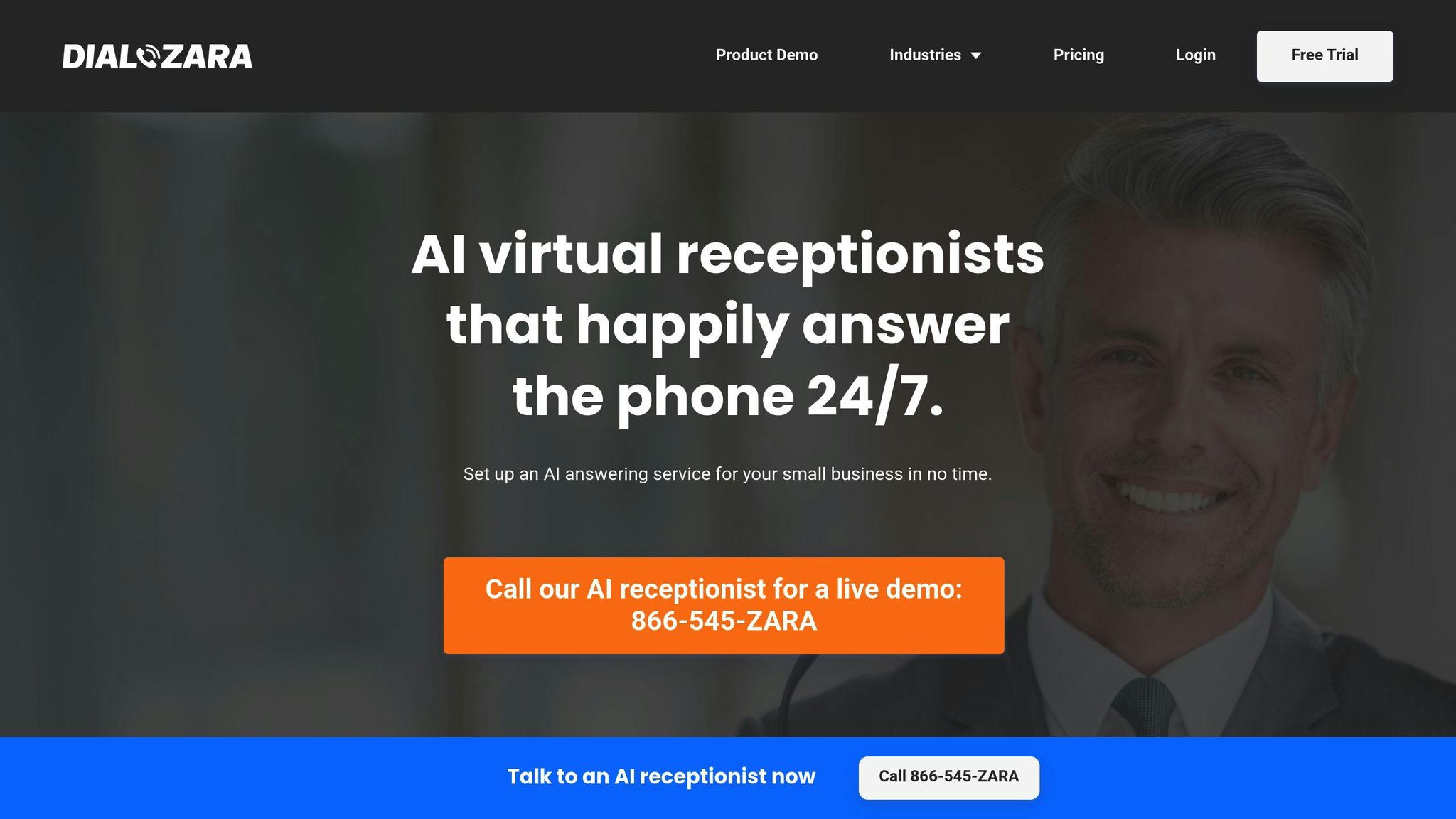AI Agent Metrics: What SMBs Need to Know

AI agent metrics help small and medium-sized businesses (SMBs) track and improve performance, cut costs, and enhance customer service. By focusing on key metrics like accuracy, speed, and customer satisfaction, SMBs can ensure their AI tools deliver real value. Here's a quick breakdown:
- Accuracy: Measures how often AI agents handle tasks correctly.
- Speed: Tracks response times and task completion efficiency.
- Customer Satisfaction: Evaluates user feedback and satisfaction scores.
- Cost Efficiency: Analyzes savings and operational impact.
- Problem-Solving Success: Looks at resolution rates and escalations to human agents.
Why it matters: SMBs can save up to 90% on costs, automate repetitive tasks, and improve service quality by monitoring these metrics. Tools like dashboards and feedback systems make it easy to track performance and adjust for better results. Start small by focusing on metrics that directly impact your business goals.
Key Metrics to Measure AI Agent Performance
For small businesses, tracking the right metrics is essential to evaluating how well AI agents are working. These insights help fine-tune performance and ensure you're getting the most out of your investment.
Measuring Accuracy, Speed, and Problem-Solving Success
Accuracy measures how often AI agents complete tasks correctly - think of tasks like categorizing customer inquiries compared to human results. Speed focuses on response times and how quickly tasks are completed, ensuring efficiency without compromising accuracy. Problem-solving success looks at resolution rates, how often issues get escalated to human agents, and the complexity of problems resolved. Metrics like first-contact resolution rates are especially telling.
Evaluating Cost Efficiency and Resource Use
Cost efficiency shows the financial impact of AI. A well-implemented system should lower costs while maintaining service quality. For example, Dialzara has achieved up to 90% savings while handling large call volumes effectively.
| Metric Category | Key Measurements | Business Impact |
|---|---|---|
| Operating Costs | Cost per interaction | Lower expenses |
| Resource Utilization | Concurrent handling capacity | Better efficiency |
| Time Management | Average handling time | Higher productivity |
Tracking Customer Satisfaction and Personalization
Customer satisfaction highlights how well AI agents meet user expectations. Tools like NPS, CSAT, and feedback surveys are great for measuring this. Personalization metrics, on the other hand, evaluate how well AI agents adjust to individual customer needs.
For small businesses, focusing on these metrics helps make the most of limited resources while keeping customers happy. Once you understand these metrics, the next step is figuring out how to monitor and use them for ongoing improvements.
How to Monitor and Use AI Agent Metrics
Tracking AI agent performance effectively calls for a mix of numbers and real-world insights. For small businesses, the focus should remain on metrics that directly affect profits while ensuring top-notch service.
Setting Up Your Monitoring Framework
Analytics tools can give you a clear picture of performance by bringing all key metrics into one place. Platforms like dashboards, feedback systems, and usage trackers offer real-time updates on how your AI agents are doing. For instance, Dialzara’s platform keeps an eye on critical metrics like response accuracy, call handling time, and customer satisfaction scores - all through built-in analytics.
Using Data to Drive Decisions
When resources are tight, small businesses benefit from letting data guide their decisions. Instead of zeroing in on single data points, look at broader trends. This approach helps you fine-tune your AI agent’s setup and training for better results.
Adding Qualitative Feedback
Numbers alone don’t tell the whole story. Qualitative feedback adds context, making it easier to assess how well your AI aligns with your business goals and customer needs. Regular reviews can provide a clearer picture of what’s working and what needs adjustment.
Connecting Metrics to Business Systems
Make sure your AI agent metrics sync smoothly with your existing business tools. This connection makes it easier to track overall impact and spot areas where processes can be improved.
sbb-itb-ef0082b
Case Study: Dialzara's Use of AI Agent Metrics

What Dialzara Offers
Dialzara specializes in AI-powered phone answering services designed for small and medium-sized businesses (SMBs). Operating 24/7, it integrates seamlessly with over 5,000 business applications, helping companies save up to 90% on staffing costs. The service also automates essential tasks like call transfers, appointment scheduling, and message relay, simplifying business workflows.
| Feature | Business Impact |
|---|---|
| Automated Call Answering | Provides round-the-clock availability without staffing expenses |
| Call Transfer Management | Ensures calls are routed to the right teams efficiently |
| Appointment Scheduling | Reduces the burden of administrative tasks |
| Message Relay | Delivers messages accurately and reliably |
| Client Intake | Streamlines the process of gathering client information |
How Dialzara Tracks Metrics to Improve Service
Dialzara leverages real-time metrics to boost performance and manage costs effectively. By combining hard data with qualitative insights, the platform ensures high-quality service while keeping expenses in check.
Key metrics include:
| Metric Category | What's Measured | Business Value |
|---|---|---|
| Response Time | Speed of call pickup and handling time | Enhances customer satisfaction |
| Resolution Rate | Completion of tasks and escalations | Ensures smooth and effective interactions |
| Cost Efficiency | Resource usage and savings | Monitors ROI and operational effectiveness |
| Service Quality | Accuracy of responses and satisfaction scores | Maintains consistent service standards |
Dialzara customizes its metrics tracking to fit the needs of different industries, such as legal, healthcare, or financial services. This approach not only ensures compliance with specific regulations but also provides actionable insights to refine services.
Why AI Agent Metrics Matter for SMBs
For small and medium-sized businesses (SMBs) working with tight budgets, tracking AI agent metrics is crucial. It ensures every dollar spent on AI produces measurable results - whether through cost savings or better customer experiences. In fact, 71% of SMB marketing teams are already using AI to turn data into actionable insights.
These metrics help businesses boost efficiency, improve service quality, and make smarter use of resources. For instance, monitoring response times and task completion rates can slash customer service costs by up to 90%. Similarly, accuracy and satisfaction scores can lead to stronger customer loyalty.
| Business Area | Metric Impact | Business Outcome |
|---|---|---|
| Operational Efficiency | Response time and task completion | Up to 90% reduction in customer service costs |
| Service Quality | Accuracy and satisfaction scores | Better customer retention and experience |
| Resource Optimization | Resource utilization and cost per interaction | Smarter allocation of business resources |
Take Dialzara, for example. By focusing on the right metrics, they’ve managed to scale their operations without sacrificing quality. Tracking performance indicators allows businesses to:
- Adjust AI agent responses by analyzing accuracy data
- Allocate resources more effectively using utilization metrics
- Improve customer experiences with satisfaction scores
- Make smarter decisions about upgrading AI systems
As AI becomes a bigger part of customer interactions, monitoring these metrics will be key to maintaining service excellence. With 60% of SMB desk workers already using or planning to use generative AI to handle routine tasks, performance tracking is more important than ever.
Instead of trying to measure everything, SMBs should zero in on metrics that directly impact their goals - like efficiency, service quality, and profitability. This focused approach avoids data overload and ensures that tracking metrics leads to real, actionable improvements. By aligning metrics with business objectives, SMBs can stay competitive and make the most of AI-driven tools.
FAQs
Now that we've covered the importance of AI agent metrics and their practical applications, let's tackle some common questions about evaluating and tracking performance.
How to Measure and Track AI Agent Performance
To measure how well your chatbot is performing, focus on metrics that directly influence your business results. Key indicators include:
- Bot Triggers and Engagement: How often users interact with the AI agent and the quality of those interactions.
- Click-Through Rates (CTR): How frequently users click on suggested options or resources.
- Agent Handoff Rates: How often issues are escalated to a human agent.
- Resolution Success: The percentage of queries the AI resolves without needing human help.
- Customer Satisfaction: User feedback and satisfaction ratings.
- Message Response Rate: The speed and relevance of the AI's replies.
- Conversation Quality: The depth and length of user interactions.
For small and medium-sized businesses (SMBs), focusing on these metrics helps fine-tune AI performance while staying efficient. Pay attention to:
- Daily interaction volumes and patterns
- Trends in user engagement
- Query resolution rates and handling times
- Customer feedback and satisfaction scores
By keeping an eye on these areas, businesses can continually improve their AI systems while ensuring consistent and reliable service.
It's important to align your tracking efforts with your specific business goals and customer expectations. Regularly reviewing and adjusting these metrics ensures your AI tools provide the best possible value and support your overall objectives.
Summarize with AI
Related Posts
Predictive AI: Enhancing SMB Customer Service
Predictive AI is transforming customer service for SMBs, enhancing efficiency, personalization, and cost savings while maintaining the human touch.
5 Key Metrics to Measure AI Customer Service Success
Discover the 5 key metrics to measure AI customer service success, including ARR, FCR, CSAT, AHT, and CES. Track these metrics to enhance the overall customer experience.
7 Key Metrics to Track AI Customer Service Success
Discover the 7 key metrics to track AI customer service success, including self-service rate, first response time, and customer satisfaction score. Learn how to measure and improve your AI service effectiveness.
AI Customer Service ROI: Measuring Real Impact
Explore how AI in customer service can significantly enhance ROI through cost savings, improved experiences, and key strategies for measuring real impact.
